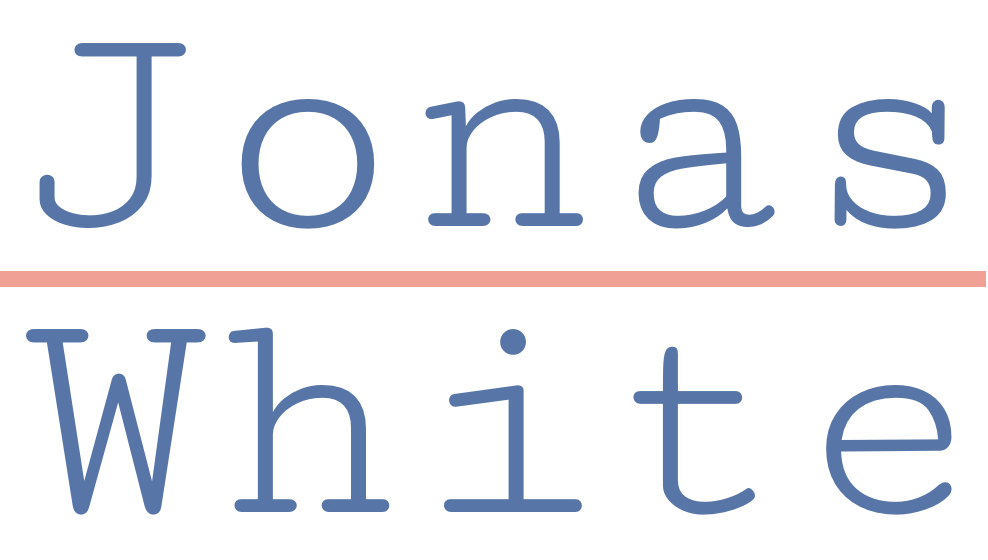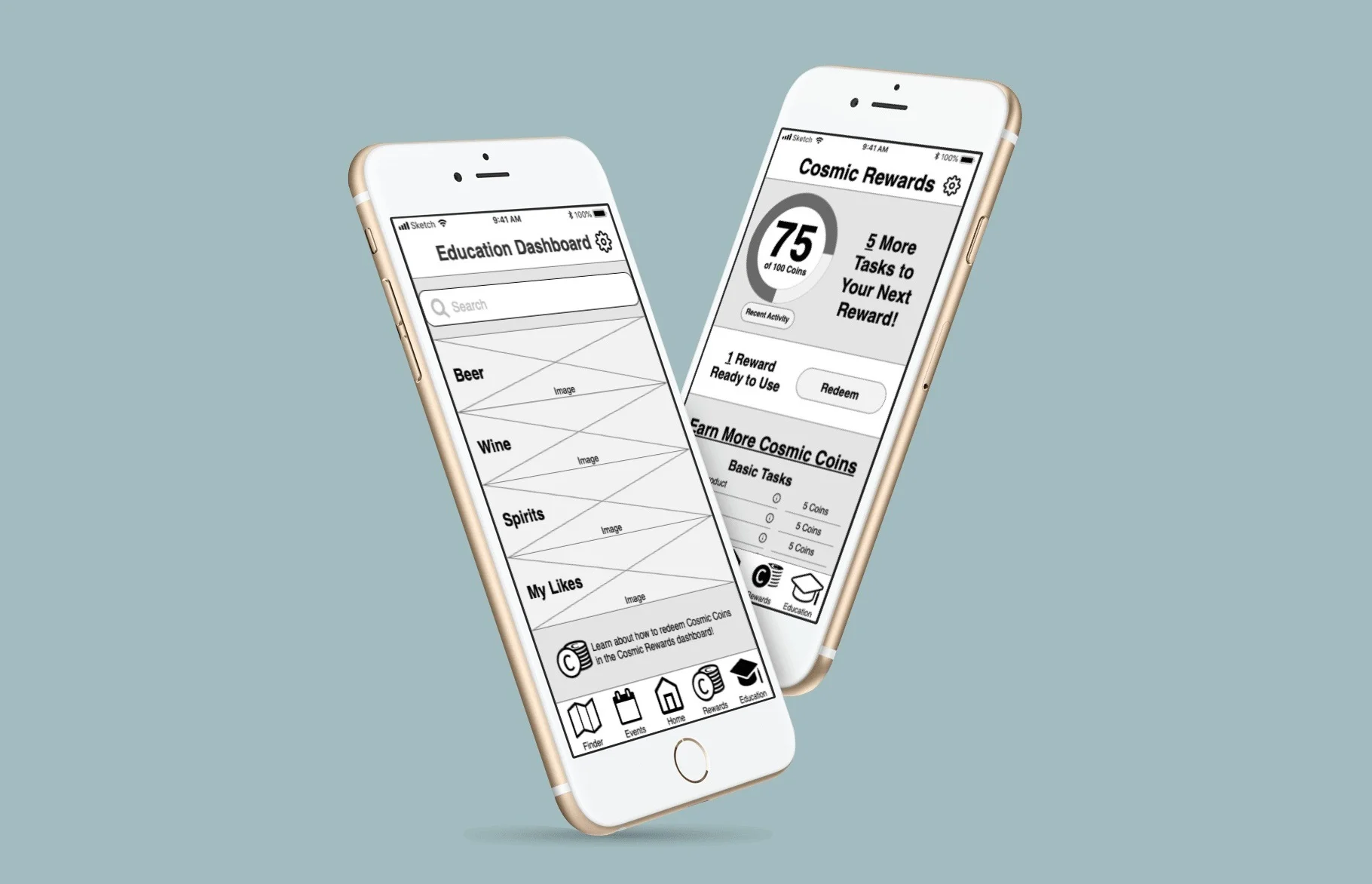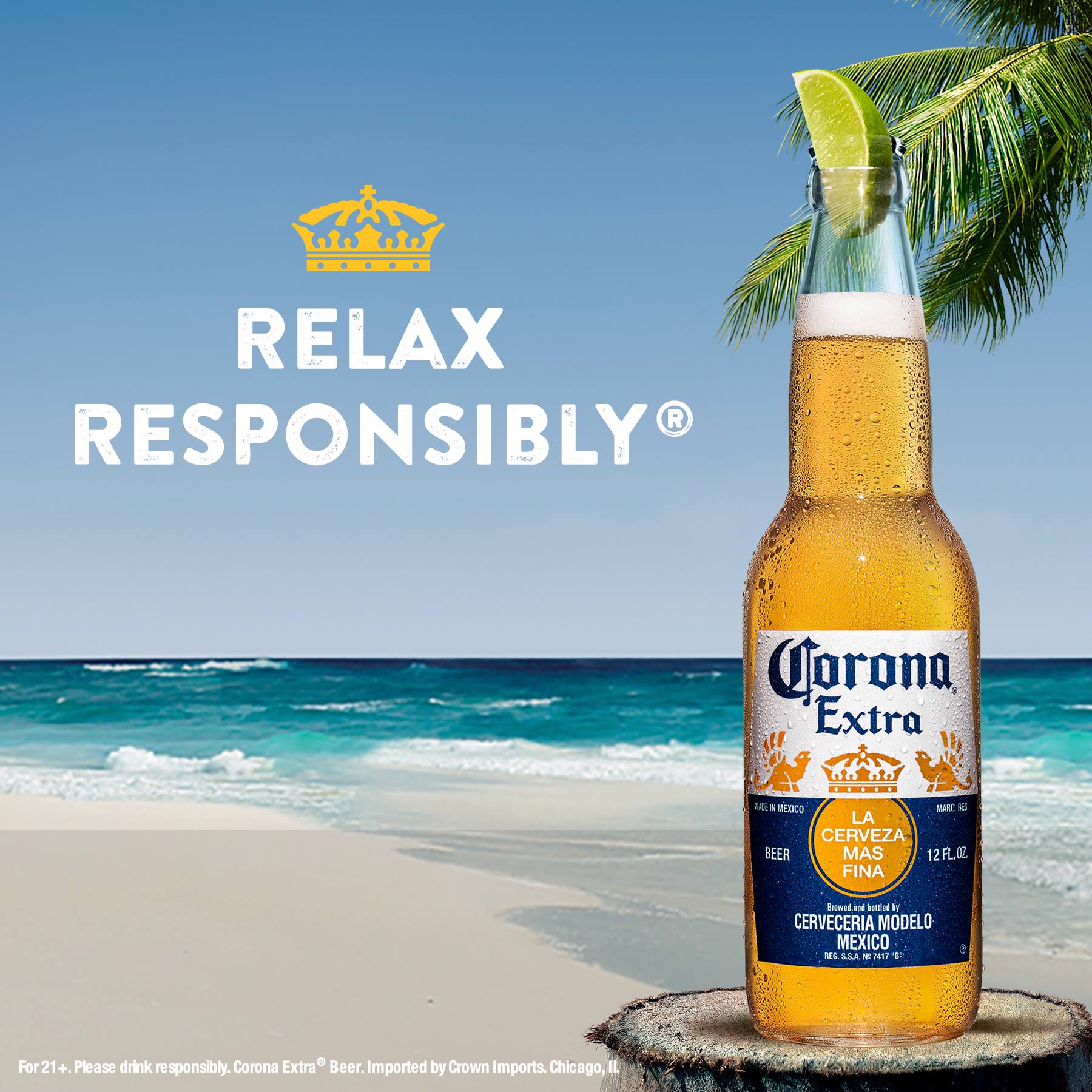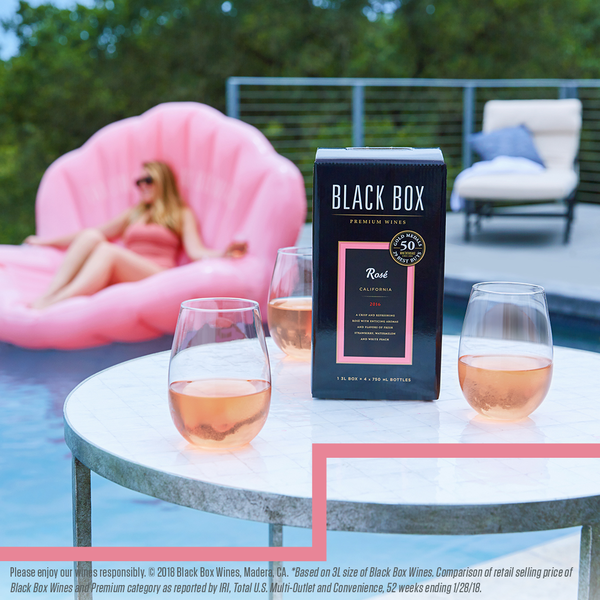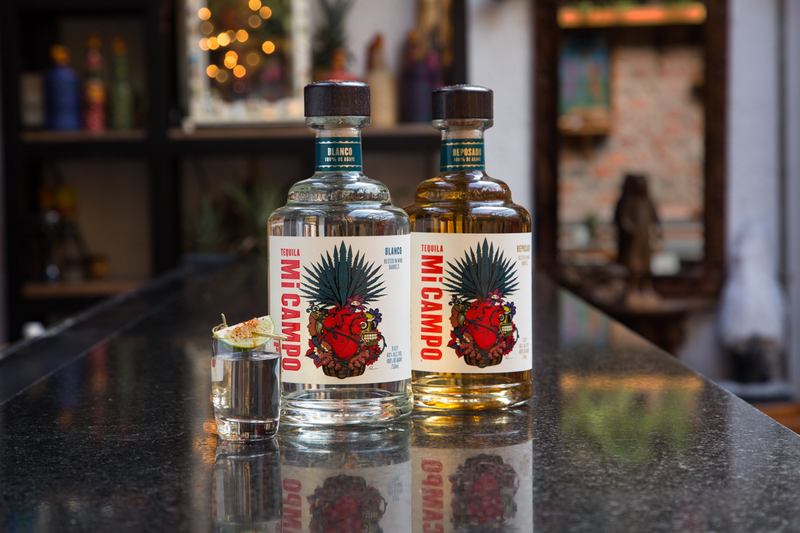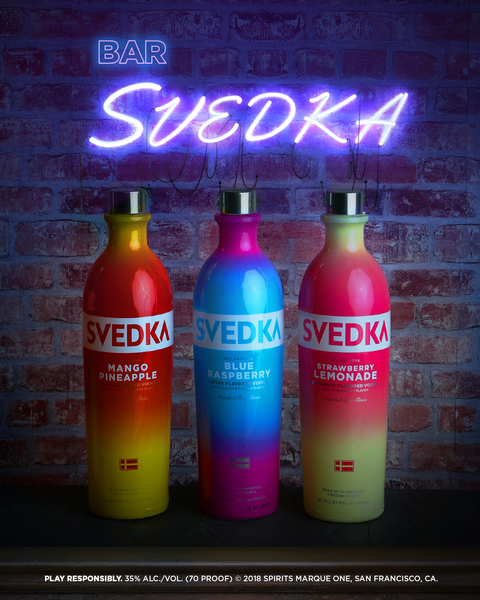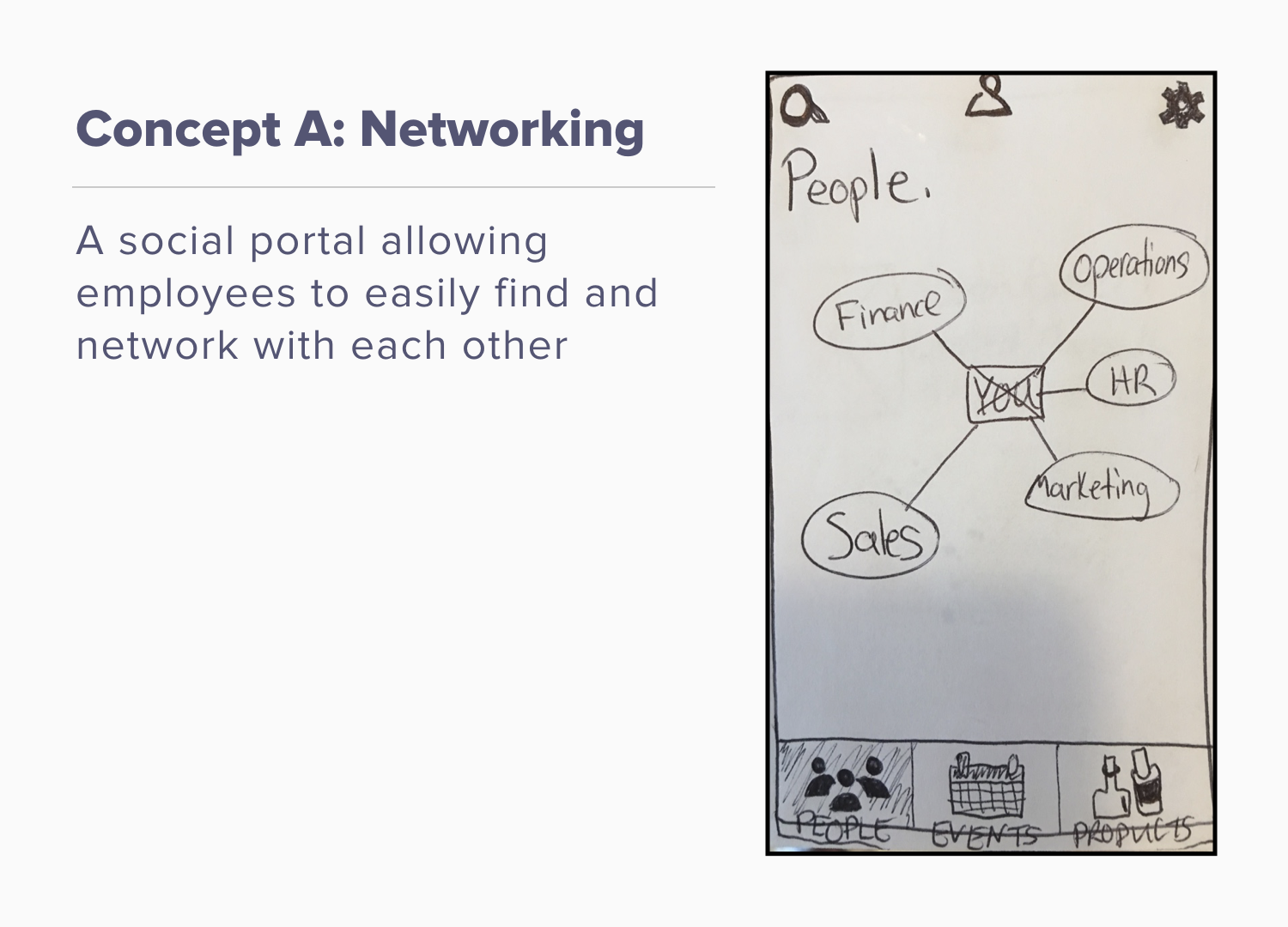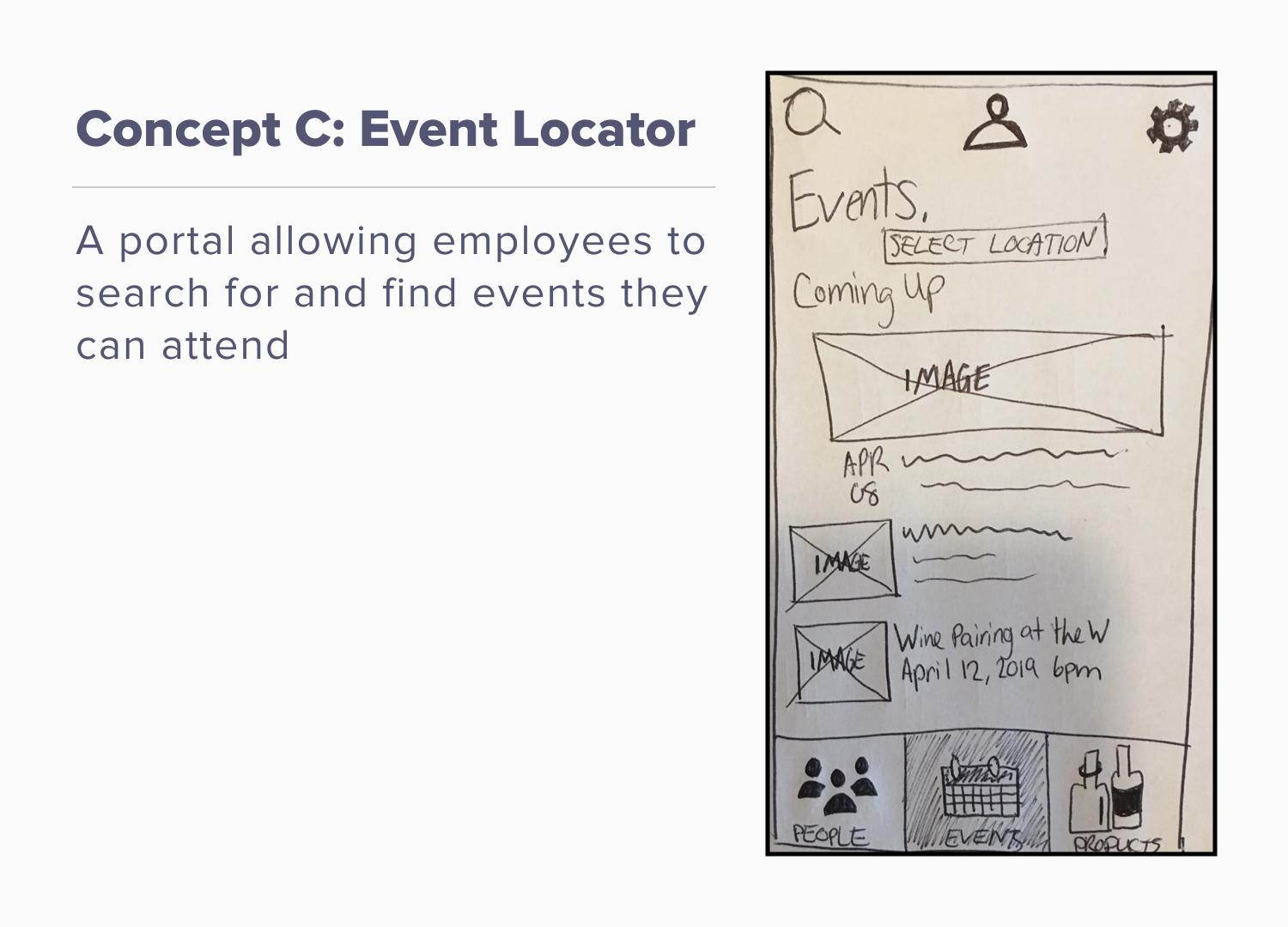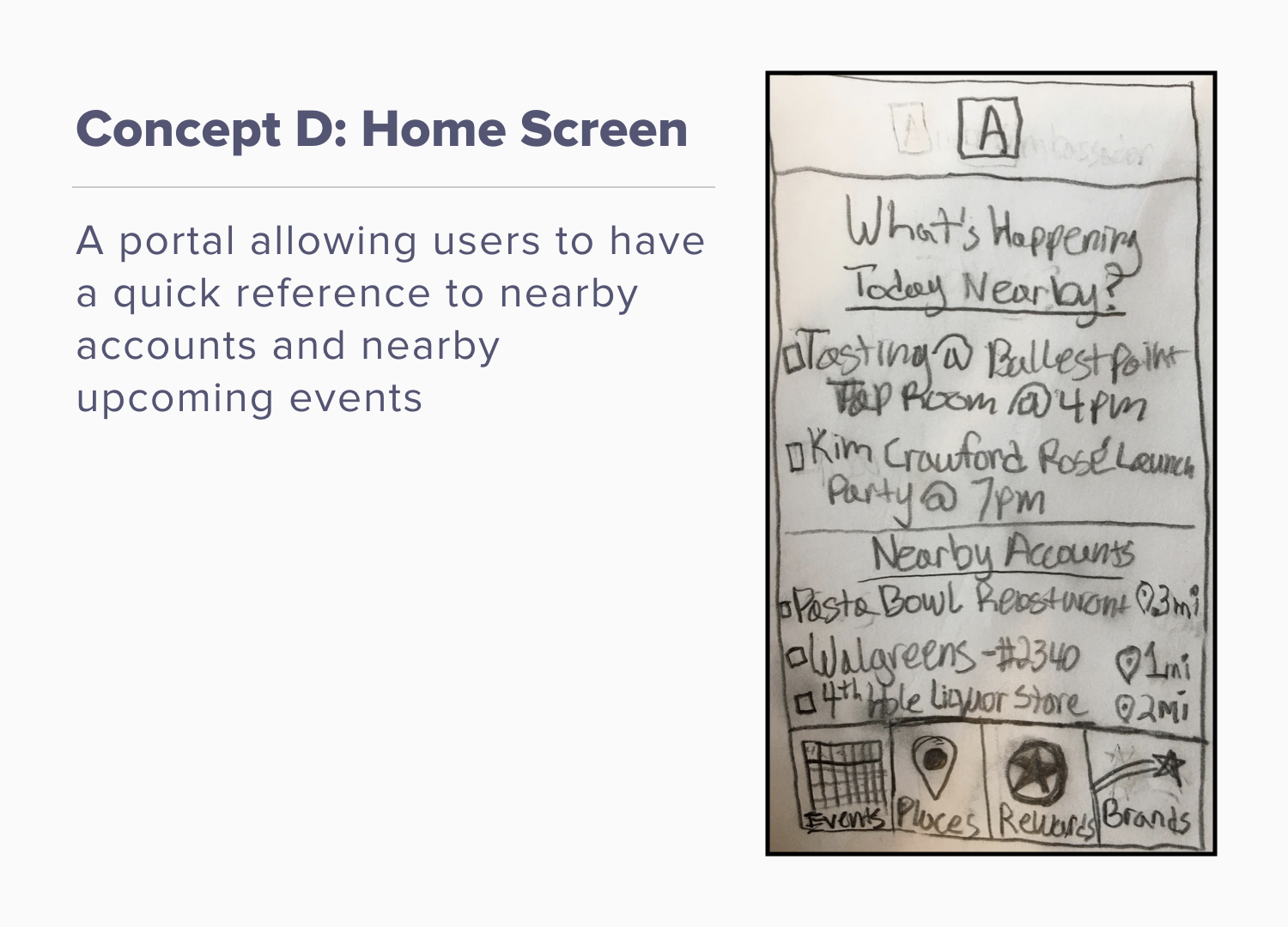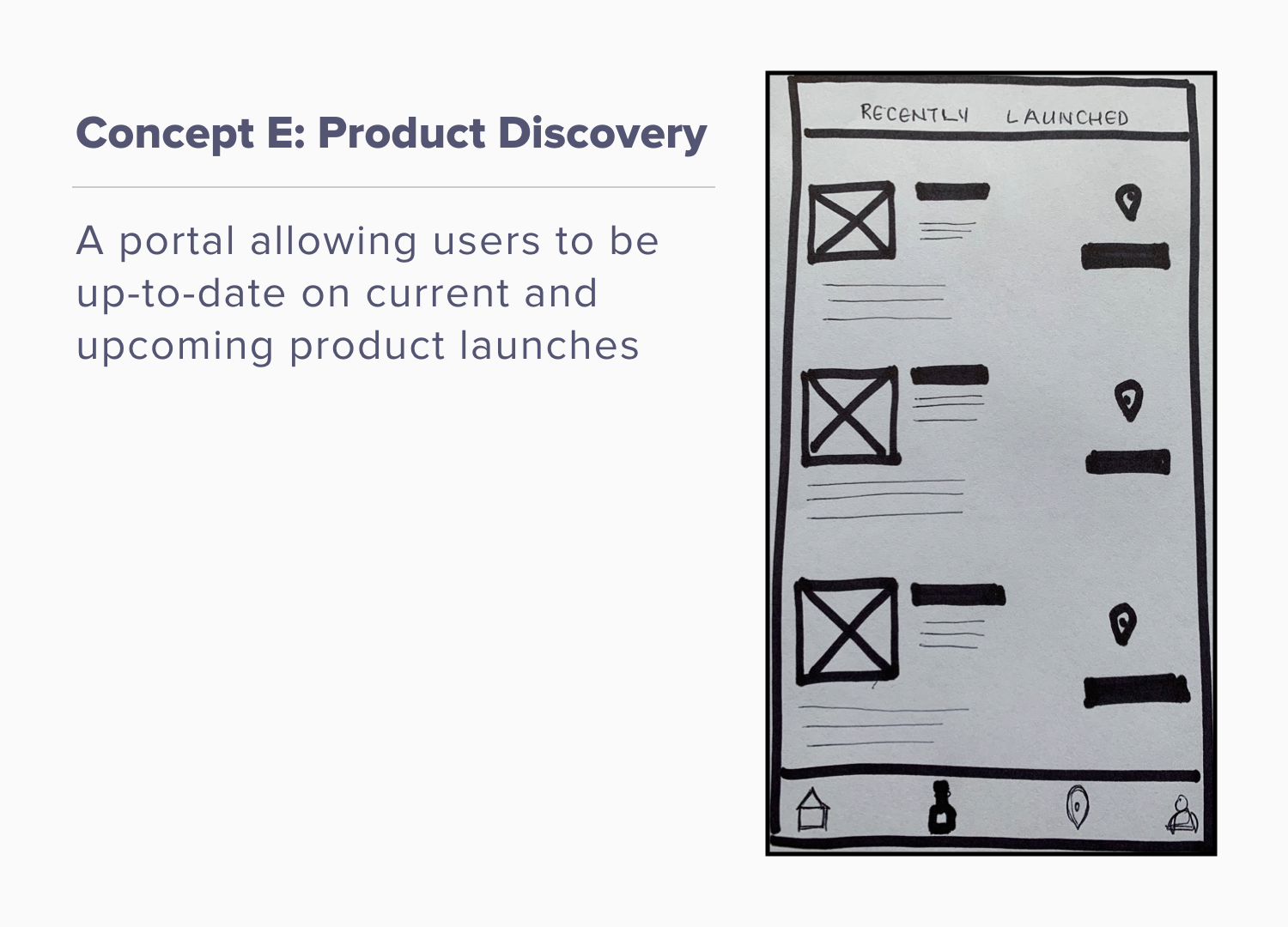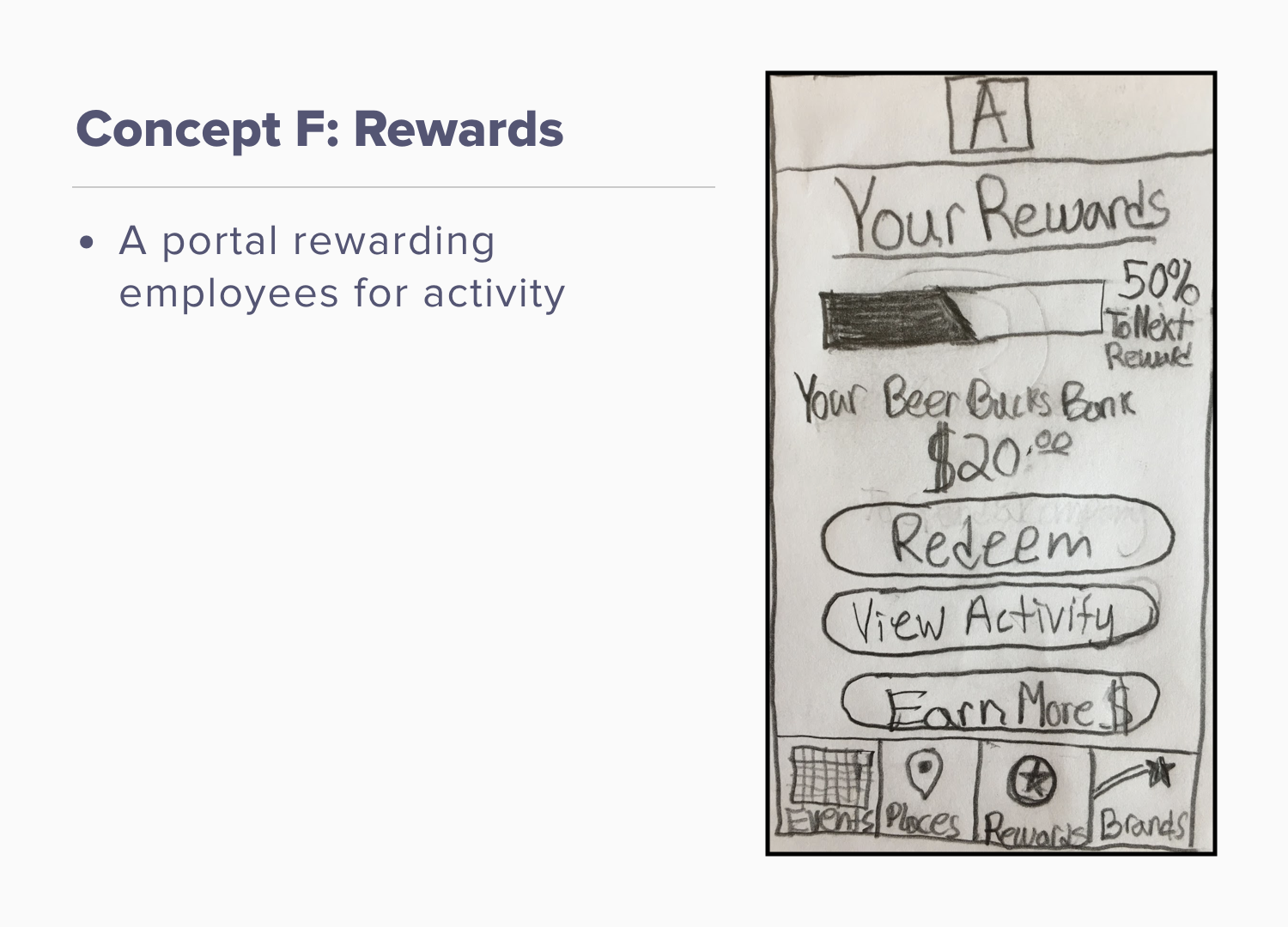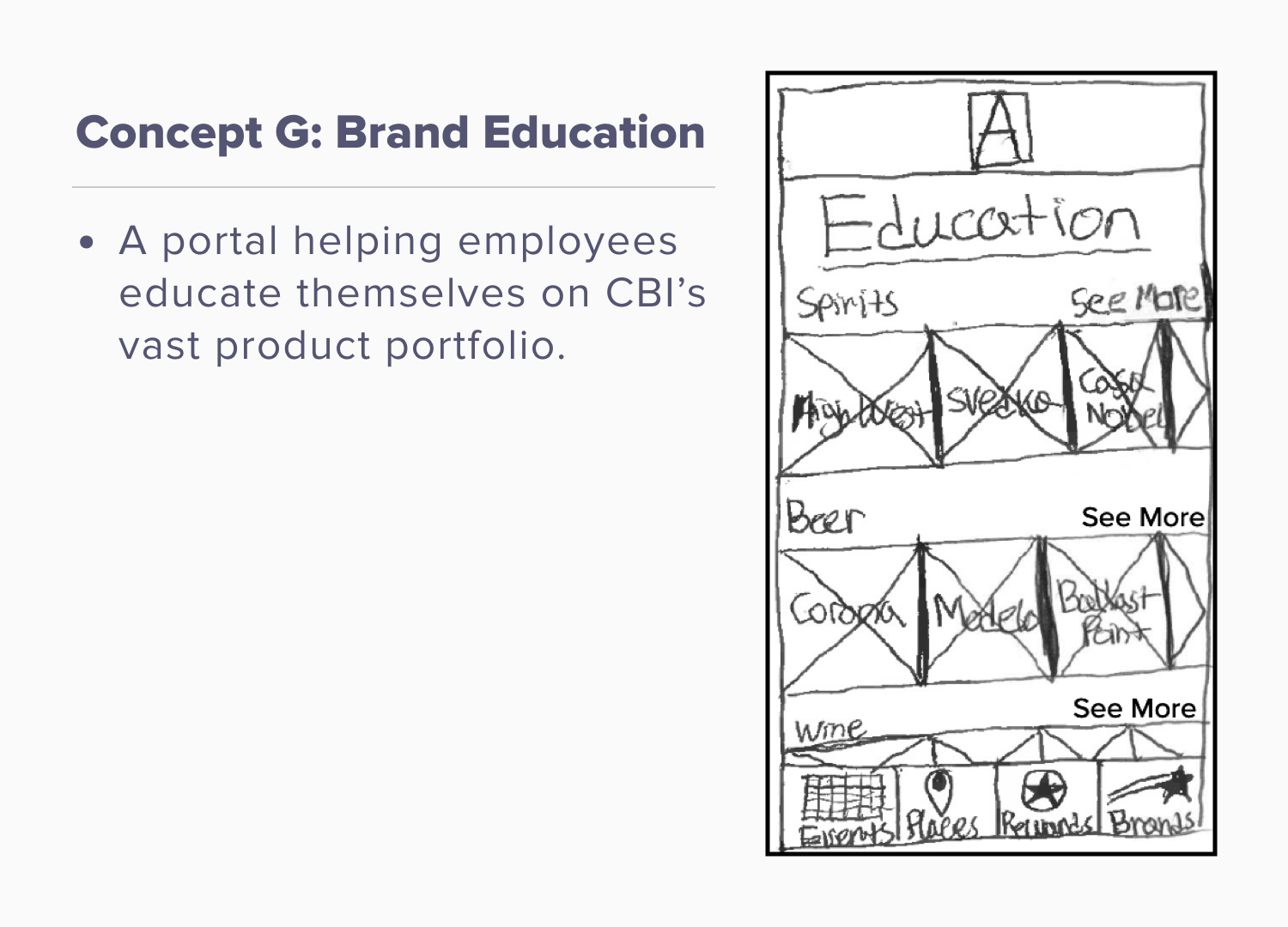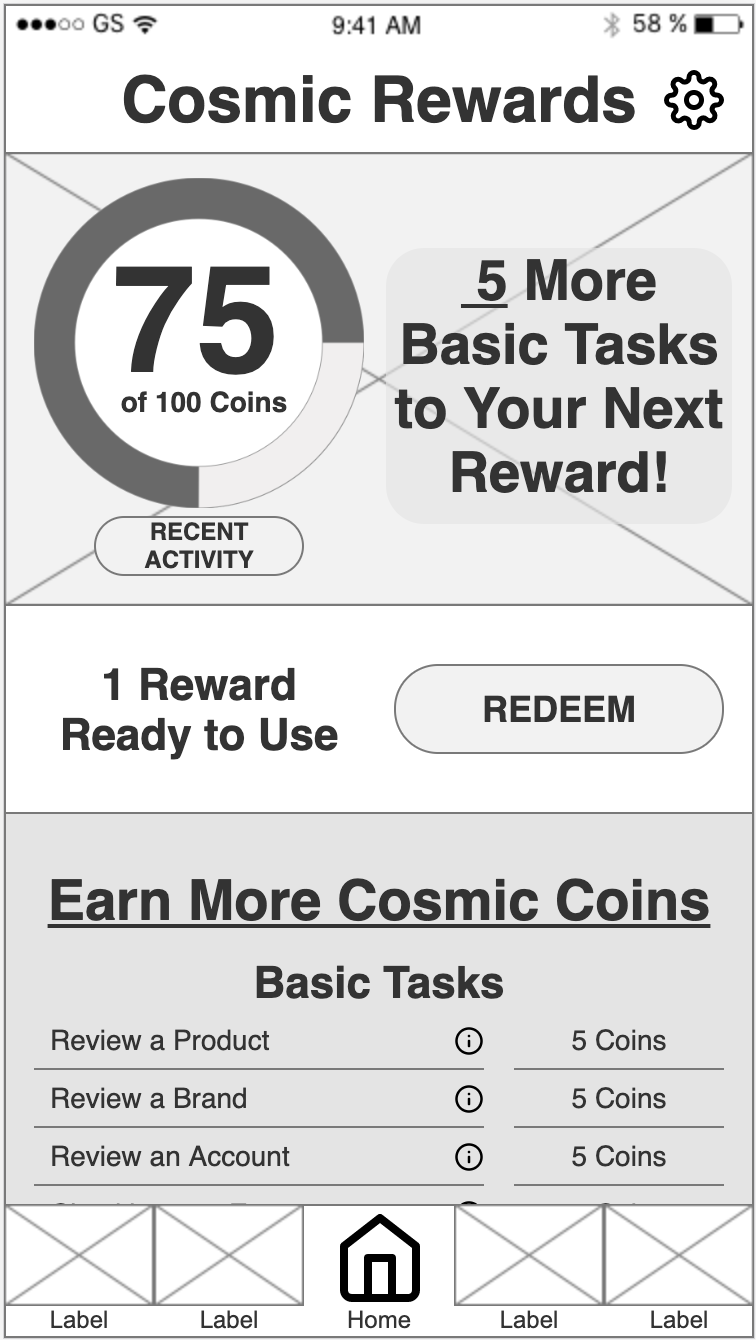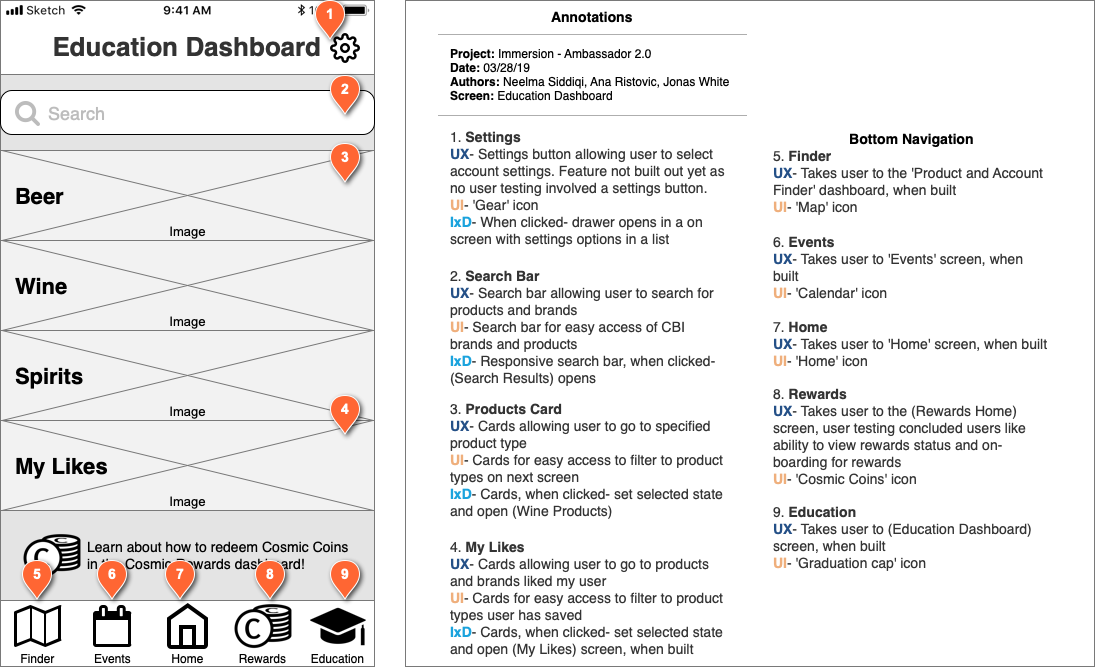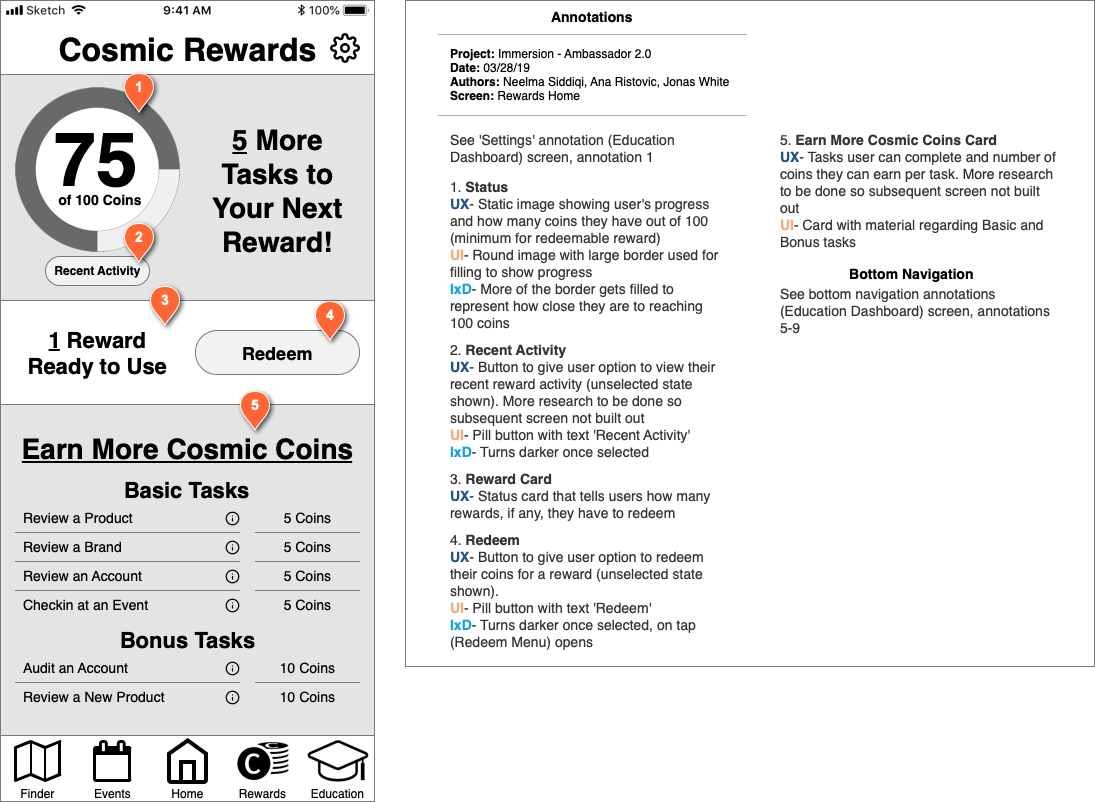Ambassador
Project Length
5 Weeks -
4 Total Sprints
Tools
Axure RP, Sketch, Xtensio
Deliverables
User Persona, Final Prototype, Annotated Wireframes, App Map
Overview
Tasked by Constellation Brands Incorporated, one of the world’s largest total beverage alcohol companies, to work with a small team of designers to research, design, and test additional features for an internally-facing native iOS mobile application named Ambassador. We delivered a mid-fidelity minimal viable prototype incorporating education and rewards features along with future recommendations for the development of the application.
Project Background & Brief
The Cosmic Client
Constellation Brands Incorporated (CBI) is a Fortune 500 total beverage alcohol (TBA) company operating in over 100 countries worldwide. CBI’s portfolio spans across wine, beer, and spirits, with brands possessing a notable amount of consumer awareness, such as Corona and Svedka. With the goal to grow their business as a whole, CBI wanted to increase brand awareness of all the portions of their portfolio and grow sales within the entire portfolio. CBI identified a strategic way to achieve this overall growth goal was to do so internally through their more than 10,000 full-time employees. To reach these employees, CBI created Ambassador, an iOS mobile application that functions as an account and product locator to allow employees to be able to find establishments where CBI products are sold or served. CBI has acknowledged that the initial rollout of the application was rough; thus, there has not been much use or awareness of the application within the company.
The Mission
CBI challenged us to identify additional features and functionality that can be incorporated into the existing Ambassador application to increase employee engagement with their branded products.
Research & Synthesis
Research Approach
With our task in hand, we formulated a plan of attack for approaching the research we needed to conduct. Our objectives for this research were to answer questions such as:
Along with these questions and knowledge gained from the project brief, we had assumptions that included:
These insights and questions helped us stay grounded and focused while conducting our research.
Talking to the Experts
We conducted two interviews with subject matter experts (SMEs). Our objective in conducting these interviews was to gain a better understanding of the business goals of the company in general as well as for the Ambassador application. We interviewed:
From these interviews, we gained three key takeaways:
Talking to the Users
Now it was time to start talking to the CBI employees who were the targeted users of Ambassador. We spoke to four individuals, all from different sectors of the company:
These interviews provided us with a plethora of insights. Here are our key takeaways:
Employees are Vested in CBI
Employees take pride in their company and want to see it succeed.
Almost every single user shared stories about how they are working to ensure CBI is always portrayed in the best possible light.
One of the users shared how when she was at her local Seven-Eleven she found the promotional sign for Corona was damaged. She wanted to report it to the Account Manager for that market, but ended up giving up because she was unable to find their contact information within Outlook on her phone.
Employees Take Full Advantage of Product Allowance
CBI allots each full-time employee a yearly product allowance based on their position within the organization to encourage CBI employees to be reaching for their products when choosing to consume alcoholic beverages and to also share these experiences with friends and family.
All users shared with us that they fully use their allowance every year.
One user shared how she ensures that restaurants she is patronizing always serve CBI products so that she can save money by using her product allowance to pay for the alcoholic beverages she and her family consume.
Word is Spread via Word-of-Mouth
CBI sponsors a plethora of events for all of its brands and products throughout the year, however, we found that there is no standardized method of letting employees know of these events, which frustrated employees who wanted to attend these events to help promote the brands
The way any employees would hear about events was by knowing someone who helped to plan them.
One user shared how he was upset because he never heard about any events until after they happen and since he is in the field most of the time, he does not get time to interact with other CBI employees face-to-face, eliminating the opportunity to network.
Lack of Knowledge of the Application
Four of the five individuals interviewed did not know about the application.
CBI acknowledged the initial rollout of the application was rough but offered no real detail on how rough it was and why. The users helped to offer the insight that they had not seen or heard anything about the application.
The one active user of the application we interviewed shared that she was only aware of the applications existence because of it being mentioned in a single email a year or two back.
Analyzing the Competition
With the insight gained from the interviews, we wanted to look at potential competitors to identify any opportunity space within the market Ambassador could take advantage of. This came with its own set of challenges. As this was an internally facing application, we could not look at CBI’s competitors’ own internally facing applications. Because of this, we looked at four mobile applications that offered services and experiences we felt aligned with CBI’s vision for Ambassador. We found each competitor excelled in two areas, outlined below.
The opportunity space for Ambassador laid somewhere within these four above areas:
Synthesis of Research Insights
To organize all of the insights obtained from our research we completed an affinity mapping activity.
Key Takeaways From Research
Employees are distraught about the lack of communication within the organization about events, products, and brands
Employees aspire to expand their knowledge of CBI’s portfolio so they can then in turn, share that knowledge with the world
Reaffirmed that CBI believed they were offering a way to increase employee engagement with their portfolio but failed to do so by not promoting the application effectively at its launch
Employees who work in specific segments of the portfolio (Beer, Wine, or Spirits) rarely venture outside of that segment, mainly because of a lack of knowledge of the other segments
Defining the User
With so many different employees in various business areas, we created a user persona general enough to address as many of them as possible yet specific enough to keep our designs focused on their particular goals and frustrations.
Pinpointing the Problem
Now that our research had confirmed CBI’s concerns with Ambassador and allowed us to gain a deep level of empathy for Renata, it was time to define the specific problem. We defined the problem as:
Social and budget-conscious employees need a way to easily find and remain up to date with where CBI products are sold so they can take advantage of their product allowances and share experiences within their social and professional communities.
To help us stay on track and steer our designs, we created design principles grounded in our understanding of Renata and the insights and business goals gained from our research.
Ideate & Concept
Brainstorming & Ideation
With a clear and outlined problem backed by solid research, we began brainstorming ways to solve our problem. We participated in multiple brainstorming activities, including Brute Think, to generate unique and creative solutions. After several rounds of ideation, we individually sketched out concepts we felt solved our problem statement. We created about 20 different concepts, which we adjusted, combined, and eliminated to get down to seven low-fidelity concepts.
Concepts Testing & Findings
We tested our concepts with three CBI employees, all with different backgrounds. Our test yielded diverse feedback, leading us to pare down our concepts from seven to three viable options. We developed these three iterated into mid-fidelity prototypes for further usability testing.
Prototype & Evaluate
The Prototypes
Based on the concept testing results, we collaborated to discuss how our best-performing concepts could be improved. Through further iteration, we developed mid-fidelity prototypes for each of these concepts. We then conducted usability testing on these prototypes.
Usability Tests
We created three tasks, one for each prototype, for our users to complete during usability testing. We evaluated the usability of the prototypes based on the user’s ability to complete the task without mistakes and their stated opinion of the ease of use. We also collected the users’ opinions on whether they would use this solution in the future. We performed these tests with two users. Both users expressed a desire for all three prototypes as well as stating they would use all three; however, users had lots of difficulties navigating the events prototype. Based on these testing results, we achieved the events concept, focusing our iterations on the concepts that tested best: brand and product education and the rewards system. After adjusting aspects of both concepts based on the results and feedback from this first round of usability testing, we converged on a final prototype.
Final Proposed Prototype
Here is the final prototype we delivered to the client:
We performed a final round of usability testing on this final prototype with users. We used tasks similar to the ones used in the last round of testing for the users to complete to evaluate the usability of the final prototype. Our key findings included our overall designs being thoughtful and easy to use, potential future integration of redemption of rewards within the application and not via email, and the need to shift around some screens so the most important call-to-action (CTA) buttons are positioned above the fold.
Annotating Wireframes
Knowing CBI would be handing off our work on this project to user interface (UI) designers for development into a high-fidelity prototype. From that point, CBI’s development team intended to build out Version 2.0 of the Ambassador application for circulation within the company. To communicate our decisions to future teams, we provided detailed annotations of our wireframes.
Communicating the Information Architecture
Knowing CBI’s intentions for the next steps for this project, we knew it was also vital to provide an app map of the final prototype to provide a high-level architecture of our solution for future teams.
Future Considerations Addressed
As part of our final presentation to the client, we presented our future considerations for the ambassador application. This took the form of the below product roadmap.
As previously mentioned, some functionality included on the bottom navigation was not built out in our final prototype. This included the events section, which we did not move forward with after concept testing due to issues with the design. However, users expressed a specific interest in having this functionality. Thus, the events functionality should be re-designed and tested and eventually be implemented into the application in an iteration in the near future. As for the Finder section of the bottom navigation, we intended this to be the existing functionality and features of the application before the start of this project. Even though making improvements to the application’s existing functionality fell outside of the scope of the project we were assigned, based on feedback from the one active user of Ambassador we interviewed, there are opportunities to improve and expand upon the functionality of Ambassador Version 1.0. As outlined in the roadmap above, we are calling for a redesign of this section of the application to improve its usability.
